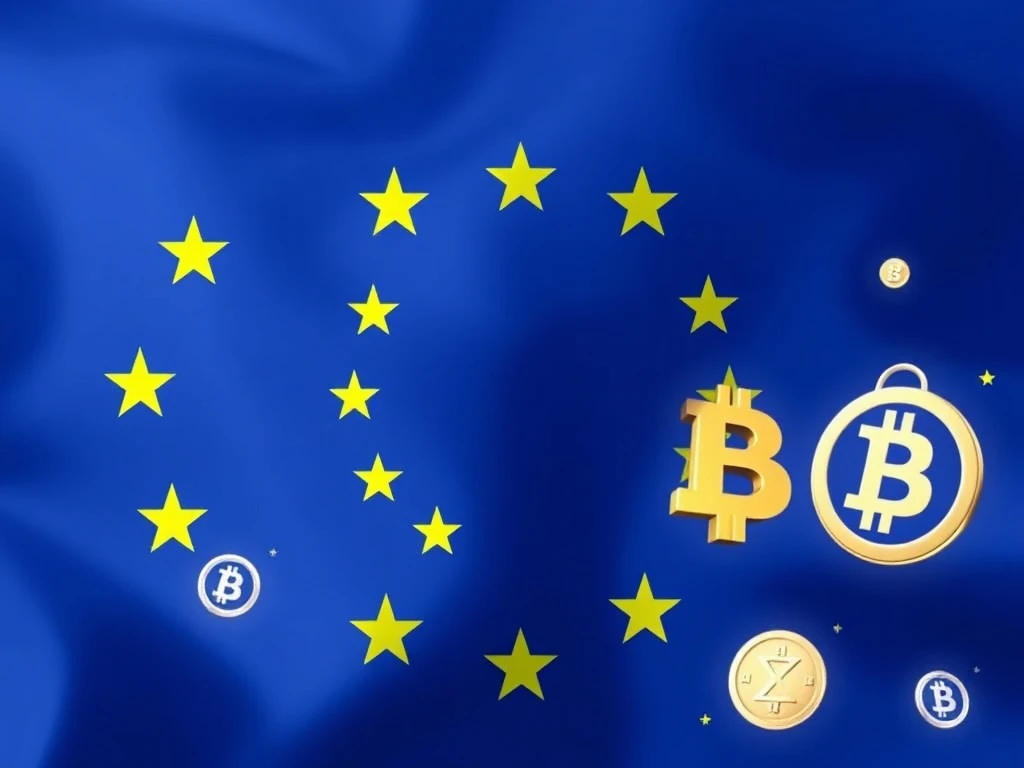MiCA Regulation: Unlocking Europe’s Crypto Future

Remember the apprehension? When the Markets in Crypto-Assets (MiCA) regulation was first proposed, many in the crypto community braced for impact, fearing it would stifle innovation and drive businesses away from Europe. Yet, less than a year into its implementation, the narrative has dramatically shifted. Far from being a burden, MiCA regulation is emerging as a powerful catalyst, reshaping the EU crypto market into a more secure, mature, and attractive ecosystem for both businesses and users. This landmark legislation, a first of its kind globally, is not just about compliance; it’s about building trust and fostering sustainable growth in the digital asset space.
MiCA Regulation: A Game-Changer for the EU Crypto Market
The European Union’s Markets in Crypto-Assets (MiCA) regulation, now operational for nearly 200 days, has defied initial skepticism. Early critics predicted it would “destroy” the European crypto industry by imposing excessive regulatory burdens and stringent user identification requirements. However, the opposite has proven true. MiCA is consolidating the European crypto industry, fostering a more robust environment, and acting as a significant catalyst for broader investor adoption. It sets a clear legal framework, bringing much-needed clarity to an evolving sector.
This clarity has encouraged prominent global crypto exchanges to establish or expand their operations within the continent. The consistent rules across 27 member states offer a distinct advantage over fragmented national regulations. This unified approach minimizes regulatory arbitrage and creates a more predictable operating environment, a crucial factor for large, established companies looking to commit resources to the region.
Consider the before and after scenarios for the EU crypto landscape:
| Aspect | Before MiCA (Fragmented Regulation) | After MiCA (Unified Regulation) |
|---|---|---|
| Regulatory Clarity | Patchwork of national laws, uncertainty for businesses and investors. | Single, comprehensive framework across 27 EU member states. |
| Market Entry for Exchanges | Complex, country-by-country licensing often required. | Streamlined process with passporting rights across the EU. |
| Investor Protection | Varying levels, often minimal, leading to higher risks. | Enhanced safeguards, strict asset segregation, clear disclosures. |
| Institutional Adoption | Hesitancy due to regulatory ambiguity and perceived risk. | Increased confidence, easier onboarding for family offices and institutions. |
| Competition | Unlicensed actors could operate with less oversight. | Fairer competition, favoring compliant and trustworthy platforms. |
How Crypto Exchanges Thrive Under MiCA
While MiCA regulation presents clear opportunities, it also introduces challenges for cryptocurrency firms. Mazurka Chen, Bybit EU managing director, noted the newness of the law means there is no established guidebook for compliance, leading to initial uncertainty during the application process. Additionally, the expense involved in achieving compliance is substantial, requiring significant time, effort, and financial investment. This cost is more readily absorbed by larger, well-established companies.
Some smaller exchanges, or those viewing the ramp-up as mere “regulatory theater” as described by Circle executives Dante Disparte and Patrick Hansen, may find it difficult to bear these costs and could exit the market. However, this outcome is seen as a positive for responsible local actors, creating an opportunity to grow a distinct European crypto asset market.
The benefits for compliant crypto exchanges are significant:
- Market Consolidation: As OKX Europe CEO Erald Ghoos stated, this consolidation separates “serious market players from unlicensed actors” and drives “healthy, trust-based competition.” This leads to a more mature and reliable ecosystem.
- Level Playing Field: MiCA-regulated firms now operate on a more equal legal footing with traditional banks and asset trading services. Georg Harer, managing director and head of global compliance at Bybit EU, highlighted that MiCA-regulated firms adhere to the same Anti-Money Laundering (AML) standards as major banks. This parity removes previous hesitations for traditional financial institutions to collaborate with crypto companies.
- Access to European Demand: For stablecoin issuers, MiCA means non-EU-related products will diminish, creating a substantial demand for MiCA-ready stablecoins. This stimulates the local stablecoin ecosystem rather than suppressing it.
- Enhanced Credibility: Obtaining a MiCA license signals a firm’s commitment to compliance and security, building trust with both retail and institutional clients. Major players like Coinbase, OKX, and Bybit have already secured their MiCA licenses, underscoring this trend.
Enhancing Investor Protection in the EU Crypto Space
The more equal footing with traditional financial institutions translates directly into tangible benefits for customers, particularly in terms of investor protection. MiCA introduces robust safeguards designed to protect client assets and ensure market integrity, which are crucial for attracting new users to the EU crypto market.
Key advantages for European crypto investors include:
- Easier Bank Transfers: “With the license, we can onboard directly, and the client will be able to make deposits and withdrawals very easily from their own bank,” explained Bybit CEO Ben Zhou. This removes a common friction point for new users.
- Broader Institutional Access: Licensing alleviates concerns for family offices and various trading institutions, allowing them to onboard with regulated crypto exchanges. This opens the door for significant institutional capital to flow into the digital asset space.
- Stronger Client Asset Safeguards: MiCA mandates strict safeguarding of client assets and funds. Georg Harer emphasized this as the most important benefit, directly addressing past failures like FTX. “You may remember FTX and others, where they reported that they had billions and billions in clients’ assets. And then, when somebody looked closely, it turned out that it was a lie or they were misused. This is now very, very strictly regulated.” This provision is designed to prevent misuse of customer funds and enhance transparency.
- Expanded Service Offerings: With MiCA and the Markets in Financial Instruments Directive (MiFID), crypto exchanges can potentially expand their offerings to include traditional assets like stocks and commodities. This provides customers with a more familiar range of investment options within a single platform.
- Increased Transparency and Disclosure: Exchanges are subject to rigorous reporting requirements, ensuring investors have access to clear and accurate information about the services and assets offered. This transparency builds confidence and enables informed decision-making.
The Global Impact of Digital Asset Regulation
The success of MiCA regulation in the EU is having a ripple effect globally. As Ben Zhou noted, “A lot of the regulators are waiting for MiCA. And you see the new framework being kind of borrowed or copied across the world.” This indicates that MiCA is serving as a blueprint for other jurisdictions seeking to establish their own comprehensive frameworks for digital asset regulation.
As more exchanges enter the European market, competition is expected to intensify, leading to better services and more innovative products for consumers. Other regions are taking notice and are moving to establish comparable crypto regulatory frameworks. Both customers and service providers are gravitating towards jurisdictions with clear regulatory guardrails, recognizing that a regulated environment fosters trust and long-term growth.
The global trend suggests a move away from unregulated wild-west scenarios towards structured, compliant ecosystems. MiCA’s pioneering role positions the EU as a leader in shaping the future of global crypto regulation, potentially influencing international standards and fostering greater interoperability across different regulatory regimes.
Summary: MiCA’s Enduring Legacy
What initially seemed like a potential roadblock for the European crypto industry has instead become a monumental leap forward. MiCA regulation has proven to be a blessing, not a burden, transforming the EU crypto market into a more secure, transparent, and attractive destination for both businesses and investors. By establishing clear rules, fostering healthy competition among crypto exchanges, and prioritizing robust investor protection, the EU has set a gold standard for digital asset regulation. This comprehensive framework is not only safeguarding participants but also actively stimulating innovation and adoption, paving the way for Europe to become a dominant force in the global digital economy. The future of crypto in Europe looks brighter and more stable than ever before.








